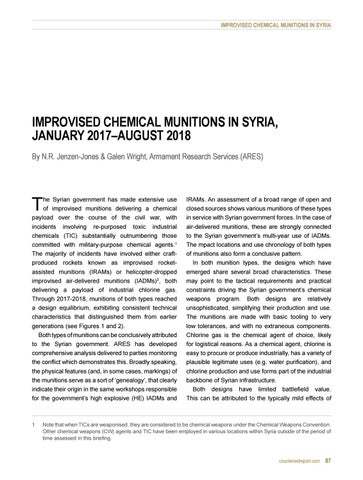IMPROVISED CHEMICAL MUNITIONS IN SYRIA
IMPROVISED CHEMICAL MUNITIONS IN SYRIA, JANUARY 2017–AUGUST 2018 By N.R. Jenzen-Jones & Galen Wright, Armament Research Services (ARES)
T
he Syrian government has made extensive use of improvised munitions delivering a chemical payload over the course of the civil war, with incidents involving re-purposed toxic industrial chemicals (TIC) substantially outnumbering those committed with military-purpose chemical agents.1 The majority of incidents have involved either craftproduced rockets known as improvised rocketassisted munitions (IRAMs) or helicopter-dropped improvised air-delivered munitions (IADMs)2, both delivering a payload of industrial chlorine gas. Through 2017-2018, munitions of both types reached a design equilibrium, exhibiting consistent technical characteristics that distinguished them from earlier generations (see Figures 1 and 2). Both types of munitions can be conclusively attributed to the Syrian government. ARES has developed comprehensive analysis delivered to parties monitoring the conflict which demonstrates this. Broadly speaking, the physical features (and, in some cases, markings) of the munitions serve as a sort of ‘genealogy’, that clearly indicate their origin in the same workshops responsible for the government’s high explosive (HE) IADMs and
IRAMs. An assessment of a broad range of open and closed sources shows various munitions of these types in service with Syrian government forces. In the case of air-delivered munitions, these are strongly connected to the Syrian government’s multi-year use of IADMs. The mpact locations and use chronology of both types of munitions also form a conclusive pattern. In both munition types, the designs which have emerged share several broad characteristics. These may point to the tactical requirements and practical constraints driving the Syrian government’s chemical weapons program. Both designs are relatively unsophisticated, simplifying their production and use. The munitions are made with basic tooling to very low tolerances, and with no extraneous components. Chlorine gas is the chemical agent of choice, likely for logistical reasons. As a chemical agent, chlorine is easy to procure or produce industrially, has a variety of plausible legitimate uses (e.g. water purification), and chlorine production and use forms part of the industrial backbone of Syrian infrastructure. Both designs have limited battlefield value. This can be attributed to the typically mild effects of
1 Note that when TICs are weaponised, they are considered to be chemical weapons under the Chemical Weapons Convention. Other chemical weapons (CW) agents and TIC have been employed in various locations within Syria outside of the period of time assessed in this briefing.
counteriedreport.com
87
